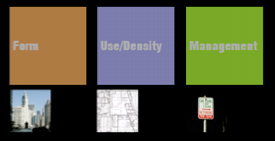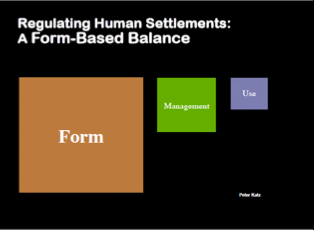A Vision for 7
Creating a better pattern of development for Route 7 in Shelburne, Vermont
FBC and Signage
The Village Wine and Coffee Shop sign that conforms with our current zoning regulations (shown above).
And the one that doesn't! It took business owner Kevin Clayton much effort and repeated visits to our town boards to obtain permission to erect this signage.
And the one that doesn't! It took business owner Kevin Clayton much effort and repeated visits to our town boards to obtain permission to erect this signage.
Under a Form-based Code design and placement of signs is integrated
with a building’s architecture to create visual continuity with other
storefronts. This positively contributes to the overall visual
environment while allowing property owners to communicate a distinctive
image and express local character. The ad hoc architectural outcomes and auto-orientation of
environments like Route 7 make it hard for businesses to effectively
communicate through signage. The location and size of signs in these
settings tends to be either ineffective or produce sign clutter. FBC
gives businesses owners’ options to achieve creative and effective sign
designs in the context of a predictable built environment.
The Route 7 Corridor is an important opportunity for Shelburne to embrace the 21st century. Rather than view it as an eyesore and painful reminder of the changes from farmland to postwar strip development, Route 7 could serve as the economic Main Street of Shelburne and its economic muscle should be embraced through sound and sustainable environmental, residential, transit and economic development.
A Vision for 7 Final Report, American Institute of Architects (AIA) Communities by Design
At the public Town Meeting and afternoon stakeholder discussions held on the first day of the SDAT, some of the comments that were used to describe Route 7 included:
- Undifferentiated
- Suburban strip
- Not Shelburne
- Could be anywhere
- Through traffic makes neighborhood circulation difficult.
A Vision for 7 Final Report, American Institute of Architects (AIA) Communities by Design
Ten Principles for Reinventing the Suburban Strip
- Ignite Leadership and Nurture Partnership
- Anticipate Evolution
- Know the Market
- Prune Back Retail-Zoned Land
- Establish Pulse Nodes of Development
- Tame the Traffic
- Create the Place
- Diversify the Character
- Eradicate the Ugliness
- Put Your Money (and Regulations) Where Your Policy Is
From Ten Principles for Reinventing America’s Suburban Strips
About Zoning Alternatives
What zoning regulates (in theory):
The system currently in place in Shelburne (and many other communities):
The Form Based Alternative:
The system currently in place in Shelburne (and many other communities):
The Form Based Alternative:
The Benefits of Form Based Code
The Shelburne FBC would:
(1) Be based on a specific community vision developed at a series of public meetings by voters and residents INCLUDING YOU!
(2) Foster a dynamic commercial real estate market by giving property owners flexibility to adapt their sites and buildings to new circumstances, such as changes in use and tenants that are a normal part of the business cycle.
(3) Generate better development outcomes in a timely and cost-efficient manner because everyone – town staff, citizen, developer - knows what’s expected at the outset of the building process.
(4) Produce a stable investment environment by providing a predictable, clear, and timely development review process, that yields coherent and desirable outcomes.
(4) Capitalize on Shelburne’s unique and unrealized potential for tourism, capture business from daily through traffic, and meet demand for local and visitor services.
(5) Help us achieve the “mix of walkable and sustainable development in the Route 7 corridor” called for in Shelburne’s Town Plan.
(6) Create housing opportunities that bring younger people, who tend to prefer walkable and transit oriented communities, to live in Shelburne.
(1) Be based on a specific community vision developed at a series of public meetings by voters and residents INCLUDING YOU!
(2) Foster a dynamic commercial real estate market by giving property owners flexibility to adapt their sites and buildings to new circumstances, such as changes in use and tenants that are a normal part of the business cycle.
(3) Generate better development outcomes in a timely and cost-efficient manner because everyone – town staff, citizen, developer - knows what’s expected at the outset of the building process.
(4) Produce a stable investment environment by providing a predictable, clear, and timely development review process, that yields coherent and desirable outcomes.
(4) Capitalize on Shelburne’s unique and unrealized potential for tourism, capture business from daily through traffic, and meet demand for local and visitor services.
(5) Help us achieve the “mix of walkable and sustainable development in the Route 7 corridor” called for in Shelburne’s Town Plan.
(6) Create housing opportunities that bring younger people, who tend to prefer walkable and transit oriented communities, to live in Shelburne.
FBC Can Promote Development and Preserve Community
Above, a rural highway:
Left Panel: Before development
Middle Panel: After conventional strip development
Right Panel: Planned with nodal development
Note that placing mixed-use buildings in front and parking in back emphasizes buildings over paved areas. Intentional development allows for preservation of rural character. (The figures depict the same square footage of development in Images 2 and 3.)
You’ve got to get a mix of uses, but the connectivity is probably even more important,” Dunham-Jones says. “The uses will come and go over time, but if you can establish a walkable network of streets, that’s when you’re really going to establish a ripple effect in changing suburban patterns.
Can ‘New Urbanism’ Bring Health to Your Neighborhood? - US News and World Report
More about a nodal design...
The concept of a Form Based Code was explored in a demonstration project that focused on the "Gateway to Shelburne" (the intersection of Route 7 and Bay Road), a potential Route 7 node under FBC. Look at how the scale of the demonstration site compares with the scale of walkable communities like Shelburne Village; Woodstock, Vermont; and Brunswick Maine! A "Shelburne Village North"? It's possible!
FBC Demonstration Area - Route 7 and Bay Road (outlined in blue)
Shelburne, Vermont
Woodstock, Vermont
Brunswick, Maine
"Wetland areas and flood zones are not allowed to be developed. However, they should not be thought of as "unusable and leftover" space. Any buildings and streets should take advantage of these spaces to increase the public use and visual character they provide."
(Wetlands and flood zones at the intersection of Route 7 and Bay Road.)
Report for Shelburne Road - The Next Step: Demonstration Project, Bill and Mary Dennis Civic Landscape Architects
Subscribe to:
Posts (Atom)
























